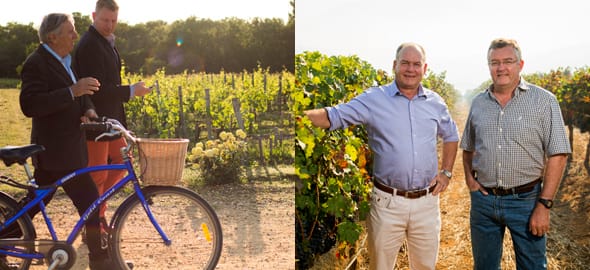
© Cape Times Friday 26th June 2015
According to all the stats, the majority of wines are drunk within a few hours of purchase, most people barely having time to chill them down before knocking them back. It’s all a part of our ‘instant gratification’ generation – ain’t nobody got time for laying down wines for 20 years, we want to drink them now! Winemakers have responded by softening acidity, toning down tannins and making easier-drinking wines which are far more approachable when young. But for some types of wine, there are still benefits in waiting and the best way is to get someone else to do the waiting for you if you can.
I’ve just returned from an outrageous trip to Bordeaux and Champagne in France courtesy of the nice folk at Emirates airlines. I say ‘outrageous’ because we visited places, met people and drank wines which I could only dream of and would never have expected to try and this amazing hospitality was down to the Emirates wine programme. Ten years ago, Emirates chairman, Sir Tim Clark, decided that the customer experience on board his planes should be the finest in the world and that part of that experience included offering the tastiest food and the very best wines. The problem with the very best wines is that for the most part, they are extremely long-lived and need time to reach their peak, generally around ten or fifteen years after being made. Aged wines rarely appear on the market, particularly not in the quantities required by an airline, so for the past decade, Emirates has been buying the wines when they’re first released and ageing them themselves.
Right now, their storage cellars in Burgundy and Dubai contain over 2 million bottles of fine wine from all over the world, slated to appear on the wine lists of First and Business Class between now and 2020 – and in the case of current En Primeurs, beyond. 2004 Château Pavie, a class ‘A’ first growth from St Emilion and a 2008 Mazoyeres-Chambertin Grand Cru from Domaine Taupenot-Merme are just two of the wines being enjoyed in the skies right now, with stocks of all the famous names – Mouton Rothschild, Margaux, Haut Brion, Yquem and more – biding their time before they make their way onto flights over the coming years. It’s a considerable investment for the airline and to the best of their knowledge, they are the only ones sourcing wines this way – most airlines ask what’s available and then buy it, as opposed to making sure of their first choices direct from the cellars
There’s no doubt that flying First Class on Emirates is a bit of a ‘once-in-a-lifetime’ experience for most of us (they have showers on board for heaven’s sake!). But if you are in this market and you care about wine, then I think you’d struggle to get this level of quality on any other airline. For those of us without a cellar, it’s an opportunity to try perfectly-aged wines in a near-perfect environment (Emirates have been able to reduce the effects of altitude in their cabins so your drinking experience is now akin to sipping wines at a mere 1,500m above sea level – not unlike drinking in the Cederberg mountains), and of course, if you’re travelling in in First or Business class, the bottles seldom run dry.
If, like me you’re hampered by exchange rates from buying overseas wines to cellar for decades, there are some excellent options closer to hand. A new release from Simonsig is The Garland 2008 (yes, they’ve kept it 7 years for you already), a Cabernet Sauvignon from a single block on a farm belonging to the extended Malan family. It’s a big, dark, brooding monster of wine which carries its hefty whack of alcohol with a light touch and is already showing more elegance and finesse than I expected. But if you can squirrel it away for another 5-8 years, I think you will be well-rewarded – I wonder if we can persuade Emirates to help with that?

